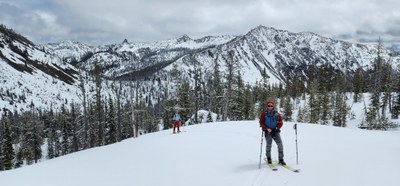
Backcountry Skiing Course
Backcountry Touring Course
Introduction to backcountry travel for skiers and snowboarders.
- Sun, Dec 1, 2024 - Wed, Apr 30, 2025
- Committee: Tacoma Backcountry Tour Committee
- Members: $435.00 Guests: $540.00
- Availability: FULL, 2 on waitlist (9 capacity)
- Cancellation & Refund Policy
Registration will be opened after the application period.
Application period opens on September 15th and will be accepted through November 15th. We're expecting it to take about two weeks to review applicants and make offers.
This Backcountry Touring Course teaches the skills and knowledge necessary to become a competent participant on day tours in the backcountry. This course welcomes both alpine skiers and splitboarders who can ski or ride downhill at an advanced intermediate (negotiate blacks diamond runs) level or better at a lift-served resort. You must be able to make turns downhill in ungroomed variable snow conditions, trees and slope angles safely and confidently. If your downhill skills are creating unsafe situations, you will be removed from the course for your personal safety.
LECTURES WILL BE HELD IN PERSON.
LEARNING OUTCOMES
- Become a competent and engaged group member on Mountaineers day touring trips rated M1-M3 (no glacier travel).
- Plan and execute day tours in the backcountry by evaluating important safety factors such as weather, terrain, avalanche risk, and group fitness.
- Demonstrate correct use of the equipment necessary for backcountry touring.
- Demonstrate mastery of backcountry touring skills such as kick turns, ascending with climbing skins, skiing downhill on touring gear with a heavy pack, and transitions.
- Selecting skin tracks.
- Selecting descent routes.
- Demonstrate successful practice of avalanche safety skills including route planning, observation, identification of avalanche hazards, and beacon use.
COURSE FORMAT
This course includes 3 required lectures and 3 required day field trips.
The field trips are experiential learning opportunities; course members will plan the tours and practice making avalanche and conditions observations and route planning decisions under the supervision of the instructors.
Note: Field trip locations and dates may change depending on weather, avalanche forecasts, road closings, instructor availability, or other conditions. Lectures will take place in person at the Tacoma Mountaineers Lodge.
Expected Schedule:
Badges you will earn:
This course has no scheduled activities.
- The Ten Essentials
- Metal-edged alpine touring (AT) or telemark skis or splitboard (nordic/XC skis without metal edges may not be used; snowboarders may not bootpack or use snowshoes for travel)
- Appropriate alpine touring boots with a ski/walk mechanism, telemark boots, or snowboard boots that work with splitboard bindings
- Appropriate alpine touring, telemark, or splitboard bindings. For alpine touring bindings, non-frame "tech" or "pin" ones are preferred
- Climbing skins that are trimmed to fit the skis/splitboard
- Poles (adjustable length preferred)
- Ski crampons that fit the skis and bindings (Optional)
- Avalanche safety tools (all required)
- Modern 3-antenna beacon (should be less than five years old)
- Collapsible probe (minimum 240cm length; ski poles that convert to a probe are not acceptable)
- Metal avalanche shovel
- Snow saw (optional)
- Repair kit
- First aid kit
- Emergency kit - shelter, headlamp
- Touring-appropriate clothing
- Ski helmet (All participants will wear a helmet during downhill activities in this course).
- Pack that can comfortably carry all of the above equipment (including your skis/snowboard). Your pack must be able to carry all critical equipment, especially the avalanche safety tools (probe, snow saw, shovel) and ski crampons, in a manner that is both secure and easily accessible, ideally inside the body of the pack, not strapped to the outside of it. It is useful if your pack also has touring-specific features such as compartments for safety tools and goggles as well as the means to securely attach or stow a helmet, boot crampons, and ice axes, simultaneously with your skis or snowboard. The first lecture will demonstrate and review proper packing and carrying of equipment.
There are no materials for this course.

 Backcountry Skiing Course
Backcountry Skiing Course
 Avalanche Level 1 Course
Avalanche Level 1 Course